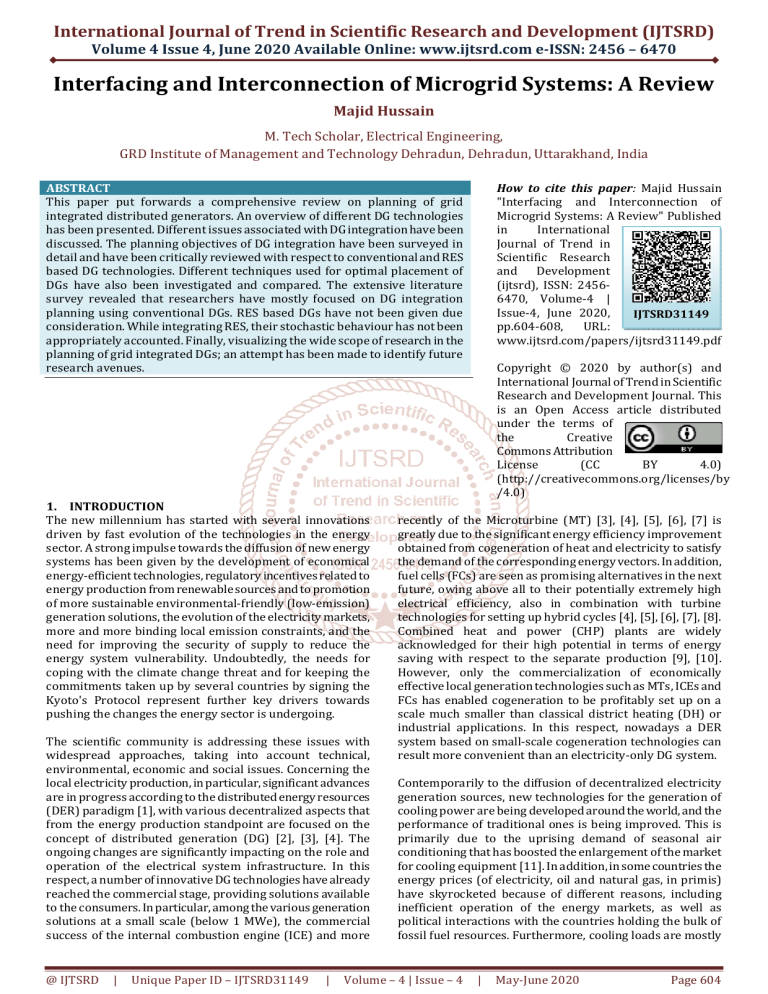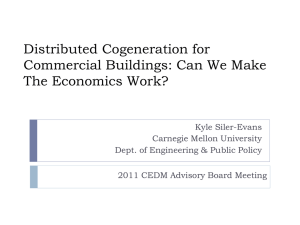Uploaded by
mail
Microgrid Systems Interfacing: A Review

International Journal of Trend in Scientific Research and Development (IJTSRD) Volume 4 Issue 4, June 2020 Available Online: www.ijtsrd.com e-ISSN: 2456 – 6470 Interfacing and Interconnection of Microgrid Systems: A Review Majid Hussain M. Tech Scholar, Electrical Engineering, GRD Institute of Management and Technology Dehradun, Dehradun, Uttarakhand, India How to cite this paper: Majid Hussain "Interfacing and Interconnection of Microgrid Systems: A Review" Published in International Journal of Trend in Scientific Research and Development (ijtsrd), ISSN: 24566470, Volume-4 | Issue-4, June 2020, IJTSRD31149 pp.604-608, URL: www.ijtsrd.com/papers/ijtsrd31149.pdf ABSTRACT This paper put forwards a comprehensive review on planning of grid integrated distributed generators. An overview of different DG technologies has been presented. Different issues associated with DG integration have been discussed. The planning objectives of DG integration have been surveyed in detail and have been critically reviewed with respect to conventional and RES based DG technologies. Different techniques used for optimal placement of DGs have also been investigated and compared. The extensive literature survey revealed that researchers have mostly focused on DG integration planning using conventional DGs. RES based DGs have not been given due consideration. While integrating RES, their stochastic behaviour has not been appropriately accounted. Finally, visualizing the wide scope of research in the planning of grid integrated DGs; an attempt has been made to identify future research avenues. 1. INTRODUCTION The new millennium has started with several innovations driven by fast evolution of the technologies in the energy sector. A strong impulse towards the diffusion of new energy systems has been given by the development of economical energy-efficient technologies, regulatory incentives related to energy production from renewable sources and to promotion of more sustainable environmental-friendly (low-emission) generation solutions, the evolution of the electricity markets, more and more binding local emission constraints, and the need for improving the security of supply to reduce the energy system vulnerability. Undoubtedly, the needs for coping with the climate change threat and for keeping the commitments taken up by several countries by signing the Kyoto's Protocol represent further key drivers towards pushing the changes the energy sector is undergoing. The scientific community is addressing these issues with widespread approaches, taking into account technical, environmental, economic and social issues. Concerning the local electricity production, in particular, significant advances are in progress according to the distributed energy resources (DER) paradigm [1], with various decentralized aspects that from the energy production standpoint are focused on the concept of distributed generation (DG) [2], [3], [4]. The ongoing changes are significantly impacting on the role and operation of the electrical system infrastructure. In this respect, a number of innovative DG technologies have already reached the commercial stage, providing solutions available to the consumers. In particular, among the various generation solutions at a small scale (below 1 MWe), the commercial success of the internal combustion engine (ICE) and more @ IJTSRD | Unique Paper ID – IJTSRD31149 | Copyright © 2020 by author(s) and International Journal of Trend in Scientific Research and Development Journal. This is an Open Access article distributed under the terms of the Creative Commons Attribution License (CC BY 4.0) (http://creativecommons.org/licenses/by /4.0) recently of the Microturbine (MT) [3], [4], [5], [6], [7] is greatly due to the significant energy efficiency improvement obtained from cogeneration of heat and electricity to satisfy the demand of the corresponding energy vectors. In addition, fuel cells (FCs) are seen as promising alternatives in the next future, owing above all to their potentially extremely high electrical efficiency, also in combination with turbine technologies for setting up hybrid cycles [4], [5], [6], [7], [8]. Combined heat and power (CHP) plants are widely acknowledged for their high potential in terms of energy saving with respect to the separate production [9], [10]. However, only the commercialization of economically effective local generation technologies such as MTs, ICEs and FCs has enabled cogeneration to be profitably set up on a scale much smaller than classical district heating (DH) or industrial applications. In this respect, nowadays a DER system based on small-scale cogeneration technologies can result more convenient than an electricity-only DG system. Contemporarily to the diffusion of decentralized electricity generation sources, new technologies for the generation of cooling power are being developed around the world, and the performance of traditional ones is being improved. This is primarily due to the uprising demand of seasonal air conditioning that has boosted the enlargement of the market for cooling equipment [11]. In addition, in some countries the energy prices (of electricity, oil and natural gas, in primis) have skyrocketed because of different reasons, including inefficient operation of the energy markets, as well as political interactions with the countries holding the bulk of fossil fuel resources. Furthermore, cooling loads are mostly Volume – 4 | Issue – 4 | May-June 2020 Page 604 International Journal of Trend in Scientific Research and Development (IJTSRD) @ www.ijtsrd.com eISSN: 2456-6470 needed when electricity rates are higher, that is, in electrical peak hours. In this respect, high cooling loads have contributed to electrical load peaking and subsequent network congestion and failure events in different power systems worldwide [12], [13]. This has strengthened the awareness of governments, manufacturers and communities about energy and environmental issues, pushing forward the search for more efficient and economic equipment for local energy generation. 2. The background frameworks 2.1. Decentralized electricity generation: background concepts on distributed energy resources The DER paradigm represents the current view of concepts like “dispersed generation and storage” and “demand side management”. In fact, the acronym DER encompasses three main aspects, whose focus is set on the electrical standpoint: distributed generation (DG): local energy production from various types of sources [2], [3], [24], [25], [26]; demand response (DR): energy saving brought by the customer participation to specific programmes for reducing the peak power or the energy consumption [27], [28], [29], [30]; distributed storage (DS): local energy storage with different types of devices. The bases of the DER theoretical framework were set up more than two decades ago [35], [36], but at that time the evolution of the technologies was not yet ready for implementation of the proposed solutions on a broad basis. Various applications have been developed during the years mainly in the industrial sector (i.e., for self-production and energy backup during emergencies). In recent years, there has been a significant diffusion of DG in several countries, while the implementation of DR and DS solutions is rapidly gaining interest [37]. Nowadays, the present technologies and economic systems are enabling the diffusion of DER applications within different energy contexts, up to the individual non-industrial users [1], [22]. More specifically, the key issues related to the diffusion of DER solutions can be summarized as follows: DG has emerged as a key option for promoting energy efficiency and use of renewable sources in alternative to the traditional generation [38]; the adoption of DER solutions can defer huge investments in new large generation plants, substations or infrastructures, whose long return time of investment does not fit with the current trend towards setting up rapidly profitable and market-orientated solutions; a multiplicity of local generation sources may lead to preferring the type of energy with higher local availability of the corresponding “fuel”, thus impacting on the development of the fuel supply infrastructures; the trend towards distributed micro-power could be significant in terms of increasing the local energy source availability, reducing both the energy dependency and the vulnerability of the electrical system from the effects of grid congestions, reducing service interruptions, blackouts, vandalism or external attacks through the formation of self-healing energy areas the development of competitive electricity markets has increased the customer participation to the market, providing solutions to exploit the price elasticity to the electrical demand [27]; @ IJTSRD | Unique Paper ID – IJTSRD31149 | the local resources connected to the electrical grid may provide benefits on the electrical network reliability (e.g., by reducing the total energy not supplied after a service interruption) and power quality (by including power conditioning options based on updated power electronics [23] within the grid interface systems); the evolution of DER technologies is leading to revisiting the standards dedicated to their interconnection to the electrical distribution systems, with definition of updated requirements concerning the protection systems; the presence of local electricity generation sources brings into play the local emission problem, above all in densely populated urban areas with plenty of potential receptors [51], not addressed with large and “far” electricity generation plants. 2.2. Multi-generation background concepts: cogeneration Cogeneration solutions can exhibit excellent overall energy efficiency and allow for significant primary energy saving with respect to the separate production of heat and electricity [9], [10]. As a consequence of the primary energy saving, CHP systems can also be an effective means to pursue the objectives of the Kyoto's Protocol in terms of greenhouse gas emission reduction. However, on a country-wise basis these benefits are strongly related to the generation mix characteristics of the relevant power system. Hence, adoption of cogeneration has been pushed forward from a regulatory point of view in several countries, above all in those ones where the power generation mix is mostly based on thermal plants, so that CHP production can also bring consistent CO2 emission reduction. Besides the incentives available for cogeneration, assimilated to renewable sources owing to its intrinsically enhanced energy efficiency and CO2 emission characteristics, CHP system profitability could be further improved by the possibility of accessing new energy-related markets (e.g., for white certificates, green certificates, or emission allowances). In addition, the possible lower overall hazardous pollutant emission [16] could further push towards adoption of CHP systems in the presence of stringent policies regarding emission constraints in terms of NOx, SOx, and so forth. Profitable deployment of CHP solutions is strongly dependent upon the presence of simultaneous demand of the relevant energy vectors in a broad time span over the year. In the past, this condition was mostly satisfied by industrial and DH installations, considering that reasons of technological scale allowed only relatively bigger plants to be cost-effective [5], [9]. Today, availability of DG technologies with good electrical and excellent overall efficiency has enabled cogeneration to be adopted also on a small-scale [7] and even micro-scale [54] basis, with suitable applications ranging from residential houses to schools, restaurants, hotels, and so forth [5]. On the basis of all these factors, CHP systems are likely to play an important role in setting new perspectives for modern and future energy system assets. 2.3. From cogeneration to trigeneration The presence of a threefold energy demand (namely, of electricity, heat and cooling) leads to the possibility of profitably setting up trigeneration plants [4], [5] also identified as combined heat, cooling and power (CHCP) or Volume – 4 | Issue – 4 | May-June 2020 Page 605 International Journal of Trend in Scientific Research and Development (IJTSRD) @ www.ijtsrd.com eISSN: 2456-6470 combined cooling, heat and power (CCHP) plants. The trigeneration concept represents an extension of CHP, that is, the production in situ of a threefold energy vector requested by the user from a unique source of fuel (e.g., natural gas). Classical trigeneration plant solutions are represented by coupling a CHP prime mover to an absorption chiller fired by cogenerated heat. In this scheme, the produced thermal power is exploited also in the summertime to produce cooling. In this way, one of the biggest shortcomings that often make cogeneration unprofitable, that is, the lack of adequate thermal request throughout the whole year, is made up for by transforming the cooling demand into thermal demand. As a consequence, the prime mover can run for longer time at averagely higher load, thus allowing for better energy and environmental performance, optimized regulation strategies and design, and shorter investment payback times [4]. Of course, adequate cooling demand in the summertime and thermal demand in the wintertime are needed to make trigeneration solutions economically feasible. In this respect, potential applications on a small-scale basis include hospitals, hotels, food industry, schools, department stores, commercial buildings, offices, residential districts, and so forth [20] besides other applications at larger scale such as airports. 2.4. Towards multi-generation From a generalized point of view to trigeneration planning, it is possible to look at the plant as a black-box (see also Section 3.2) with an array of inputs and a manifold output. Hence, the trigeneration planning problem can be extended to encompass the analysis of different equipment for electrical, thermal and cooling generation, besides the classical schemes with absorption chillers fed by cogenerated heat [20]. In particular, different solutions can be envisaged for the local production of cooling power. Among these, it is possible to mention electrical chillers, direct-fired absorption chillers, and engine-driven chillers. All these solutions may have a heat recovery option, so leading to potentially set up a cooling-and-heat cogeneration system to be coupled to a “classical” electricity-and-heat cogeneration systems. The analysis of different trigeneration alternatives (components and schemes) may become particularly interesting when cooling generation is needed not only for air conditioning, or in any case not only for the summertime span (seasonal trigeneration). In this respect, it must be pointed out that most of equipment for cooling generation are reversible, so that they could actually operate under both cooling mode and heating mode. This simplifies the plant schemes and improves the plant economy, owing to the possibility of saving the purchase of some equipment and of better exploiting the CHP production. In fact, the variety of technologies that can be adopted in the trigeneration plants allow for optimally managing the different energy vectors inside the plant in order to endeavour the most viable and effective solutions (also on the operational level) for different types of applications and from different standpoints (energy saving, emission reduction, minimum costs, and so forth). Considering the combination of CHP systems with different technologies for thermal/cooling generation, the enthalpy levels at which thermal/cooling power can be produced can be manifold. For instance, heat generation equipment such as electric heat pumps could be used to produce hot air for @ IJTSRD | Unique Paper ID – IJTSRD31149 | space heating, while a cogenerator such as an ICE could produce hot water for domestic use and steam for feeding an absorption chiller. Hence, from the point of view of considering the physical carriers that are generated for carrying different forms of energies, it is possible to identify cases of tri-generation, quad-generation, and so forth, depending on the number of outputs. In this respect, the trigeneration concept can be further generalized by introducing the rationale of multi-generation, as referred to the production of electricity, cooling power and heat, with the two latter ones in case available at different enthalpy (temperature/pressure) levels. Furthermore, the concept of multi-generation can encompass the provision of additional outputs such as hydrogen, dehumidification, or other chemical substances used in specific processes. The overall picture is that the energy system designer has now a wide range of alternatives to combine together to set up a local energy system for manifold energy production. Effective combination, at the planning and at the operational stage, of these different alternatives can bring enhanced benefits in terms of energy efficiency, emission reduction, economic profitability, and reliability and quality of the service provided to the user [16]. 3. The distributed multi-generation (DMG) approach 3.1. A novel decentralized energy generation paradigm Availability of thermal-based local power plants, whose thermodynamic and technical characteristics allow for multigeneration applications, may change dramatically the economics and the convenience of the local generation itself, even for market-niche technologies [100]. In particular, the combined occurrence of various benefits from DER and multi-generation makes the bridge between the decentralized electricity generation and solutions for production of other energy vectors. This paves the way to the effective deployment of local multi-generation systems, stepping beyond the DG rationale, already defined as “the paradigm of the new millennium” [4], towards the even more innovative DMG approach. In the light of the above premises, the applications developed in the decentralized energy production area can be categorized, in structural and functional terms and in the increasing order of complexity, as A. classical cogeneration (single input fuel, double output, single site); B. multi-generation (single/multiple input fuel, manifold output energy vectors, single site); C. distributed multi-generation (single/multiple input fuel, manifold output energy vectors, multiple sites). The distinction among single site and multiple sites refers to the physical location of the energy systems with respect to the energy infrastructures. In particular, single site solutions are most focused on the conversions among various types of energy to satisfy the local demand (typical of industrial plants). Instead, the case of multiple sites takes also into account the local delivery of the related energy vectors through suitable infrastructures [41]. In this respect, the electrical grid or electricity distribution system (EDS), the gas distribution system (GDS), a DH network and a district cooling network (DCN) are infrastructures already encountered today. In addition, solutions with multiple fuel may include the supply of the thermal equipment with bio- Volume – 4 | Issue – 4 | May-June 2020 Page 606 International Journal of Trend in Scientific Research and Development (IJTSRD) @ www.ijtsrd.com eISSN: 2456-6470 fuels [102] or bio-masses [103], [104], as well as hybrid solutions coupling the local generation equipment to solar or wind energy systems. A Hydrogen distribution system (HDS) could also be envisaged in the next years within a hydrogen economy scenario, for carrying in the energy vector to supply the plant (input) or to deliver it out to further systems after local generation and in case storage in the plant (output) [108], [109]. On the above considerations, apparently DMG solutions could show the highest potential within urban areas, where interconnected infrastructures and variety of energy demand are mostly available. 3.2. Structures, components and energy flows in DMG systems A multi-generation plant can be conceptually seen as composed of the combination of local subsystems producing electricity, heat, cooling, hydrogen and so on. Fig. 1 shows the basic layout with the relevant energy flows (normally not simultaneously present). In addition, although not shown in the figure, other products/effects such as various chemical compounds or dehumidification can represent relevant multi-generation outputs. The various technologies currently available for cooling (as well as heat) generation can be heat-fired or electricity-fired, so allowing for various combined schemes with CHP systems. Combination of cogeneration technologies to various thermally fed systems such as absorption or engine-driven chillers [14], [15], [16], [17] allow for setting up a so-called tri generation system. In addition, high-efficiency electroenergetic technologies such as electric heat pumps [14], [16] well fit into the existing energy systems to enhance the overall performance. This kind of combined systems can exhibit excellent energy, environmental and economic performance. Indeed, feeding different technologies with different fuels for producing different energy vectors gives birth to a variety of alternatives for more effective design and planning of the energy systems. In addition, the possibility of co-generating hydrogen and of using it as a storage energy vector, in case exploiting volatile electricity production from renewable sources such as wind or sun, represents a further variable that could be advantageously exploited. Hence, the possible benefits from the combined production of multiple energy vectors (e.g., electricity, heat, cooling, hydrogen, or other chemical products) paves the way to future scenarios focused on the development of multi-generation (or polygeneration) solutions. All the above aspects lead to substantial changes in the global vision of the energy sector, calling for structuring a comprehensive framework of analysis. In particular, the scientific literature is relatively recently addressing the local production of energy by using different approaches and viewpoints. Several specific frameworks have been formulated within the scientific communities dealing with energy resources, power systems, environmental impact, economic and financial analysis, and so forth. However, nowadays the interconnections among the energy-related issues are so tight that an interdisciplinary view for bridging the gap among the various standpoints is indispensable. A survey of the relevant publications on scientific journals in the last years (2001–2007) shows that the largest part of these publications is still related to cogeneration. However, the number of research papers related to multi-generation @ IJTSRD | Unique Paper ID – IJTSRD31149 | concepts and applications is lately exploding. Very recent reviews have been focused on comprehensive energy modelling [18], large-scale approaches and methods to decentralized energy planning [19], technologies for combined cooling, heat and power production [20], and structured frameworks for addressing the evolution of the electrical systems in terms of diffusion of DER [1], [21], [22], [23]. 4. Conclusions The development of DMG systems represents a close horizon for the future energy systems moving beyond the centralized and electricity-only generation paradigm. This paper has outlined the main possible structures, characteristics, components, energy flows and interactions for DMG systems. In addition, several and various emerging approaches presented in the most recent scientific literature have been reviewed, that can be encompassed within the DMG paradigm. Sustainability of the DMG solutions is guaranteed by a wide range of technical and economic benefits. In fact, DMG system scan provide the user with enhanced energy and environmental performance, higher quality of the energy services, and, in terms of economic operational optimization, the possibility of flexibly running the plant according to variable prices of gas, electricity, and of other energy-related commodities. In addition, DMG systems can bring an array of potential benefits to the community, including primary energy saving, optimal fossil and renewable energy sources exploitation, emission reduction of CO2andotherhazardous pollutants, better electrical grid reliability and operation and thus decreased power system vulnerability. REFERENCES [1] Pec ̧as Lopes JA, Hatziargyriou N, Mutale J, Djapic P, Jenkins N.Integrating distributed generation into electric power systems: a reviewof drivers, challenges and opportunities. Electr Power Syst Res 2007;77(9):1189–203 [2] Jenkins N, Allan R, Crossley P, Kirschen D, Strbac G. Embeddedgeneration. IEE Power and Energy Series 31. London, UK: The IEE;2000. [3] Willis HL, Scott WG. Distributed power generation: Planning andevaluation. New York: Dekker; 2000 [4] Borbely AM, Kreider JF, editors. Distributed generation—the powerparadigm of the new millennium. Boca Raton, FL: CRC Press; 2001. [5] The European Educational Tool on Cogeneration (EDUCOGEN),December 2001, available (August 2007)www.cogen.org/projects/edu-cogen.htm [6] US Environmental Protection Agency. Catalogue of CHP Technologies;August 2007. Availablewww.epa.gov [7] Onovwiona HI, Ugursal VI. Residential cogeneration systems: review ofthe current technology. Renew Sustain Energy Rev 2006;10(5):389–431 [8] Macchi E, Campanari S. Potential development for gas microturbines.Hybrid cycles and trigeneration. Cogen On-Site Power Prod 2001;2(2):41–9. [9] Horlock JH. Cogeneration-combined heat and power (CHP). Malabar,FL: Krieger; 1997 Volume – 4 | Issue – 4 | May-June 2020 Page 607 International Journal of Trend in Scientific Research and Development (IJTSRD) @ www.ijtsrd.com eISSN: 2456-6470 [10] Martens A. The energetic feasibility of CHP compared to the separateproduction of heat and power. Appl Therm Eng 1998;18:935–46. [11] Afonso CFA. Recent advances in building air conditioning systems. ApplTherm Eng 2006;26(16):1961–71. [12] Pourbeik P, Kundur PS, Taylor CW. The anatomy of a power gridblackout. IEEE Power Energy Magazine 2006;4(5):22–9 [13] Makarov YV, Reshetov VI, Stroev VA, Voropai NI. Blackout preventionin the United States, Europe and Russia. Proc IEEE 2005;93(11):1942–55. [14] Kreider JF, editor. Handbook of heating, ventilation and air conditioning.Boca Raton, FL: CRC Press; 2001. [15] American Society of Heating, Refrigerating and Airconditioning Engi-neers. ASHRAE HVAC systems and equipment handbook, SI Edition.ASHRAE; 2000 [16] Danny Harvey LD. A handbook on low-energy buildings and districtenergy systems: Fundamentals, techniques, and examples. UK: Jamesand James; 2006 [21] Alfonso D, Pe ́rez-Navarro A, Encinas N, A`lvarez C, Rodrı ́guez J,Alca ́zar M. Methodology for ranking customer segments by their suit-ability for distributed energy resources applications. Energy ConversManage 2007;48(5):1615–23. [22] Maribu KM, Firestone R, Marnay C, Siddiqui AS. Distributed energyresources market diffusion model. Energy Policy 2007;35(9):4471–84. [23] Carrasco JM, Franquelo LG, Bialasiewicz JT, Galvan E, Portillo GuisadoRC, Prats MAM, et al. Power-electronic systems for the grid integrationof renewable energy sources: a surveys. IEEE Trans Indust Electr 2006;53(4):1002–16. [24] Ackermann T, Andersson G, So ̈der L. Distributed generation: a defini-tion. Electr Power Syst Res 2001;57(3):195–204. [25] Pepermans G, Driesen J, Haeseldonckx D, Belmans R, D’haeseleer W.Distributed generation: definition, benefits and issues. Energy Policy2007;33(6):787–98. [26] Alanne K, Saari A. Distributed energy generation and sustainabledevelopment. Renew Sustain Energy Rev 2006;10:539–58. [17] U.S. DOE. Review of Thermally activated technologies. Distributedenergy program report, July 2004; August [27] Kirschen DS. Demand-side view of electricity markets. 2007. IEEE TransPower Syst 2003;18(2):520–7. Availablehttp://www.eere.energy.gov/de/publications [28] Levy R. Avision of demand response—2016. Electr J .html 2006;19(8):12–23. [18] Jebaraj S, Iniyan S. A review of energy models. Renew [29] Valero S, Ortiz M, Senabre C, Alvarez C, Franco FJG, Sustain EnergyRev 2006;10:281–311. Gabaldon A.Methods for customer and demand [19] Hiremath RB, Shikha S, Ravindranath NH. response policies selection in newelectricity markets. Decentralized energy plan-ning; modeling and IET Gener Transm Distrib 2007;1(1):104–10 application—a review. Renew Sustain Energy [30] Sezgen O, Goldman CA, Krishnarao P. Option value of Rev2007;11:729–52. electricitydemand response. Energy 2007;32(2):108– [20] Wu DW, Wang RZ. Combined cooling, heating and 19 power: a review. ProgEnergy Combust Sci 2006;32:459–95. @ IJTSRD | Unique Paper ID – IJTSRD31149 | Volume – 4 | Issue – 4 | May-June 2020 Page 608




